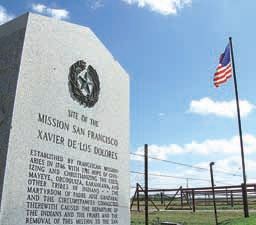Milam County Historical Commission
Milam County, Texas
Milam County, Texas






All articles from the Temple Daily Telegram are published with the permission of the
Temple Daily Telegram.
All credit for this article goes to
Jeanne Williams and the Temple Daily Telegram
Temple Daily Telegram.
All credit for this article goes to
Jeanne Williams and the Temple Daily Telegram
Lost treasure of the San Xavier Missions
by Jeanne Williams
Temple Daily Telegram - August 23, 2010
SAN GABRIEL - The treasure that lies beneath the grazing meadows and furrowed ground near
the San Gabriel River off FM 908 most likely is only of historical wealth, but that has
not quelled 250 years of tales and legends of Spanish gold believed to be hoarded in
Milam County land.
"There is no truth to this scientifically from all of the archival documents and
archeological work that has been done," said Dr. Jim Bruseth, Texas Historical Commission
director of archeology. "If all of the stories of lost gold or buried treasure in Texas
were true, I estimate about 80 percent of the world's supply of gold and treasure would
be in our state."
Buried treasure stories abound, however, and those in search of ancient riches are not
easily convinced that they are merely folklore, said historian Joy Graham of Rockdale.
"There have been treasure seekers in Milam County looking for that gold," Mrs. Graham
said. One treasure hunter leased Sugar Loaf Mountain, the sacred summit of the Tonkawa
Indians, specifically to search for gold, she said.
The man moved a bulldozer to the top of the mountain, devastating that whole area. He
scraped off the top,” Mrs. Graham said. “To my knowledge there has never been any gold
found either at the three mission sites, nor on or around Sugarloaf Mountain. Property
owners of these locations have had to run people off their property for looking for
‘treasure.’”
Several versions of one story had a Spanish mule train burdened with gold traveling
through Milam County.
Forced by hostile Indians or other circumstances to bury their gold, the Spaniards, in
this tale, ultimately murder someone and place the corpse on top of the treasure to
protect it from looters. Sites of this buried gold range from near the Brazos River, the
Little River and the San Gabriel River, and some are connected with ghost stories. Other
tales are set at the San Xavier mission site, where rumors will not die concerning lost
or buried sacred communion cups, candlesticks and crosses made of pure gold.
The mid-18th century Spanish government that ruled the wild Texas frontier decided in the
1740s to colonize the area now known as Milam County by opening three Roman Catholic
missions close to the San Gabriel River: the San Ildefonso, Nuestra Senior de la
Candeleria and the principal mission, San Francisco Xavier de Horcasitas.
The settlement was beleaguered by strife between Spanish soldiers, priests, colonists and
Indians. When a Spanish soldier murdered a priest who denounced his sinful life and had
him excommunicated from the church, the settlement witnessed a scary sight — a ball of
fire in the sky circled the area. Some believed the fire ball represented the wrath of
God, who cursed the presidio that soon was plagued by disease and a drought so severe the
river dried up. The missions were abandoned in 1755 leaving behind charred ruins,
intrigue and tales of hidden gold that won’t stay buried.
A legend divulges that in less than 12 years after the departure of church furnishings
and valuables, rumors of buried riches kept the mission sites marked on the maps of
treasure hunters.
One of the most popular stories to materialize into print came from J. Frank Dobie’s
“Legends of Texas Volume I: Lost Mines and Hidden Treasure” published in 1924 by the
Texas Folklore Society.
“Buried Treasure Legends of Milam County” written by Louise von Blittersdorf maps out a
fascinating yarn supposedly handed down in Mexico through a Spanish family of the theft
of a large solid gold cross and sacred gold items used by priests at the San Xavier
missions in Texas. In this version angry Indians wanting to destroy the missions murdered
a priest, prompting Spaniards to abandon the mission. They buried the priest and the gold
items at the mission site.
Many years later when a church was being built in Mexico, an elderly Mexican man came
forward with the story of the buried cross and treasure asking a priest to accompany him
to the San Gabriel River area in Central Texas to find the gold cross to use on the new
church.
The old man died en route to San Gabriel and the priest was forced to return to his
congregation but he entrusted the journey to a young Irishman named Mike Welch, who
promised to fulfill the task. The burial sites were found, but Welch was double-crossed
by one of his men, who apparently found the cross and other gold items and ran away in
the night. This story has been proven false by archaeological research, said Mrs. Graham,
who worked with respected archaeologist, the late Dr. Kathleen Gilmore, on the history of
the missions. Dr. Gilmore led an archaeological dig in 1967 at the San Francisco Mission
and researched Roman Catholic records in Spain for details on the Milam County missions.
At 94, Dr. Gilmore planned another dig in Milam County, but she died earlier this year.
“I do know first-hand from research of Dr. Gilmore on the crosses from the missions,”
Mrs. Graham said. “According to the missionary diaries she used in her research all of
the golden crosses were taken to San Marcos along with other mission furnishings and left
there until the missions were built in Menard.”
jwilliams@tdtnews.com
History, not treasure, is the only riches to be found at the site of three 18th Century Spanish Missions.
Photo by Shirley Williams/Telegram
.
Photo by Shirley Williams/Telegram
.
